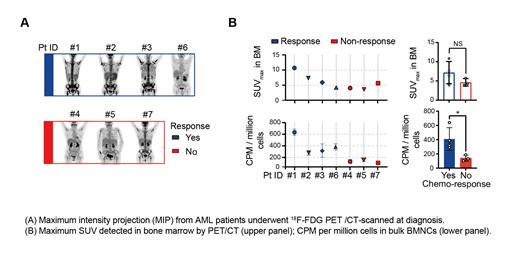Metabolic re-programming enables cancer cells to harness various carbon substrates for energy production and biomass synthesis. Cell-intrinsic mechanisms of preferential glucose uptake is reported in acute myeloid leukaemia (AML). We previously identified leukaemia cells uptake more glucose compared with bone marrow micro-environment (BMME) cells in a MLL-AF9-driven AML mouse model (Leukemia 2023;37:1407). It is unknown how glucose is partitioned in the bone marrow, and whether glucose uptake variation correlates with response to induction chemotherapy in persons with newly-diagnosed AML. The radionuclide-labeled glucose analog 18F-2′-deoxy-2′-fluorodeoxyglucose ( 18F-FDG), a positron emission tomography (PET) probe, can be used to quantify in vivo glucose uptake in this setting. We studied this via a prospective pilot study (NCT05919199) in subjects with newly-diagnosed AML before receiving induction chemotherapy.
Of 7 patients who have been enrolled in the study to date, all subjects were presented with various intensities of diffuse bone marrow 18F-FDG uptake in PET/CT images (maximum standardized uptake value (SUV max) mean, 6.0; range, 3.8-10.6). Subjects with higher SUV max in bone marrow had a higher likelihood of achieving a remission after induction therapy (Figure A).
We use a 18F-FDG probe combined with magnetic-activated cell sorting (MACS) to quantify glucose uptake ( 18F radioactivity) in bulk and/or fractionated cell populations from subjects with AML at diagnosis. The associations between 18F-FDG uptake and response was better defined by per-cell glucose uptake quantification ( 18F counts per minute (CPM) per million cells) of bulk bone marrow cells. Higher 18F-FDG uptake correlated with a higher remission rate (Figure B). Notably, leukaemia cells from responders metabolized more glucose compared with micro-environment cells both of which had higher glucose uptake compared with non-responders. In contrast, leukaemia cells from non-responders had markedly decreased glucose uptake compared with micro-environment cells even they were sharing the same metabolic pool. These data indicate subject-specific glucose uptake is not directly affected by glucose availability but by cell-intrinsic glucose uptake programs.
In light of data implicating mitochondrial metabolism in preserving leukaemia stem cells we speculated other energy sources such as amino acids and, fatty acids might compensate for decreased glucose uptake in non-responders. We utilized a computationally metabolic fluxome model, scFEA (Genome Res 2021;31:1867), which characterizes stochiometric relationships of metabolic networks and principal component analyses based on metabolism-related transcripts clustered samples by response. scFEA analysis of RNA-seq indicated responders had higher flux in the glucose import module, while flux of glutamine uptake were enriched in non-responders. These results suggest a switch from glucose (“Hot” AML) to glutamine metabolism (“Cold” AML) may protect leukaemia cells from chemotherapy stress.
Taken together, we provide a rationale for in vivo evaluation of glucose uptake in AML patients, which is of potential use in discriminating patient response or resistance to induction therapies.
Disclosures
No relevant conflicts of interest to declare.


This feature is available to Subscribers Only
Sign In or Create an Account Close Modal